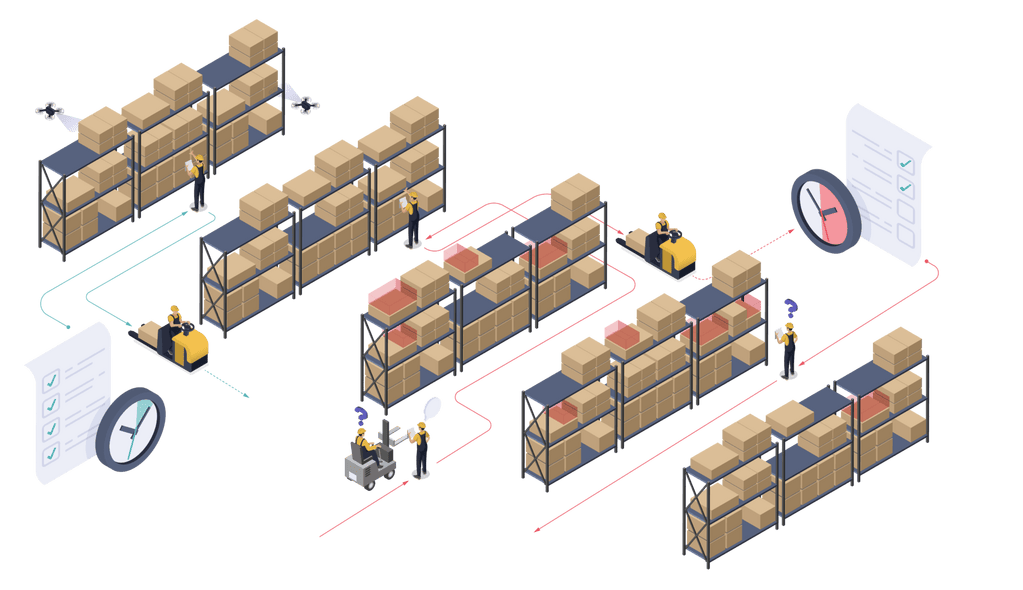Unlock warehouse productivity
6 keys to optimizing inventory management

Optimizing inventory management requires more than a snapshot of where inventory is located at one moment in time. It is when pallets are moved—which happens at high frequency throughout every day—that errors occur and productivity is significantly impacted. Changing that equation requires the ability to scan inventory anytime, anywhere, based on changes rather than static locations. By scanning the right locations based on movements, you can be assured that inventory is finally in the right place at the right time.
To gain the full potential of inventory automation, seek a solution that tackles the issues that matter most.
1. Automate high-frequency scanning of moved pallet locations
In warehouses of every size, one of the greatest challenges is tracking inventory in motion—into the warehouse, out of the warehouse, and at every location in between—with zero errors. In this dynamic environment, the potential for errors is massive, and every error that takes place directly impacts warehouse efficiency, increases costs, and decreases service, leading to lost customers. True improvements are achieved when moved locations are scanned frequently to identify errors as they happen. With the flexibility to scan anytime, anywhere, based on changes rather than static locations, efficiency and productivity soar.
Imagine if in a library, one out of twenty books is filed in the wrong section.
How would visitors find that book? How would the library staff know where it is?
The time lost searching for each book would be immense—all due to unresolved, unnecessary errors.
2. Insist on zero-touch operations
Fully autonomous systems operate without any human intervention or oversight. While ‘highly automated’ inventory drones may reduce the amount of human labor required to scan inventory, a zero-touch system does much more by enabling 24/7 operations, 100% consistency that drives predictable outcomes, and efficient, optimized operations. With a zero-touch system, scanning types and schedules are determined digitally via a dashboard, and drones execute the scanning missions autonomously without any human interaction or supervision needed. Verity is the only system on the market to offer this capacity, enabling 90% savings on labor costs tied to inventory tracking.
3. Focus on data intelligence—not simple data collection
Successful automation must do more than simply imitate and automate human processes. Automated systems should augment and amplify human capabilities. An intelligent, data-driven system should do all the heavy lifting (including processing, decision-making, and optimization) once the user has identified which inventory insights are needed. Whether these insights are based on contracts, regulatory requirements, WMS (Warehouse Management Systems) data, or other factors, a smart inventory system can translate these into specific, relevant inventory counts—without any human interaction. This intelligence supports the development of consistent, error-free processes and faster product throughput, while significantly reducing the amount of time required by workers to get the job done right.
4. Use purpose-built inventory drones to increase value and reduce TCO
Drones are built to do many things. In the warehouse, the purpose of drones is inventory management. To do that—and do it best—purpose-built drones offer features not available on commercial drones that are simply repurposed to replace handheld inventory scanners in the warehouse. Verity drones are designed to last 200 times longer than conventional commercial drones. The Verity system is enabled by a proprietary, purpose-built indoor navigation system. Plus, full vertical integration means Verity can provide seamless customer service and maintenance. An integrated inventory tracking system that uses autonomous drones built to capture precise data in complex warehouse environments is designed to evolve and adapt to changes over time. The result: greater value at a lower cost over the lifetime of the system
5. Use a lightweight system fit for implementation at scale
Not all drones are equal. Verity offers the lightest-weight drones on the market today, and we are constantly striving to reduce the size and weight of our inventory drones. This focus on weight reduction delivers a variety of benefits to users. Lightweight drones accelerate the implementation process, support all types of inventory counts (wall-to-wall, cycle counts, spot checks), can be easily placed anywhere in the warehouse to reserve valuable floor space, and offer a nearly unlimited ability to adapt to changing warehouse environments (size, height, aisle width, areas, etc.)
6. Demand significant productivity improvements
Automating inventory tracking offers numerous advantages, such as reallocating worker focus, eliminating high-reach tasks, enhancing customer service, and reducing costs. Yet the greatest benefit of full automation is heightened productivity. Locating misplaced pallets in a 10K-location warehouse can consume an hour. In a 100K-location setting, that escalates to three or more hours daily. Self-flying drones can swiftly pinpoint location errors, provide actionable insights for process refinement, and ensure efficient, error-free inventory handling from dock arrival to customer dispatch. Based on current installations Verity enables productivity gains up to the equivalent of 4 full-time employees.